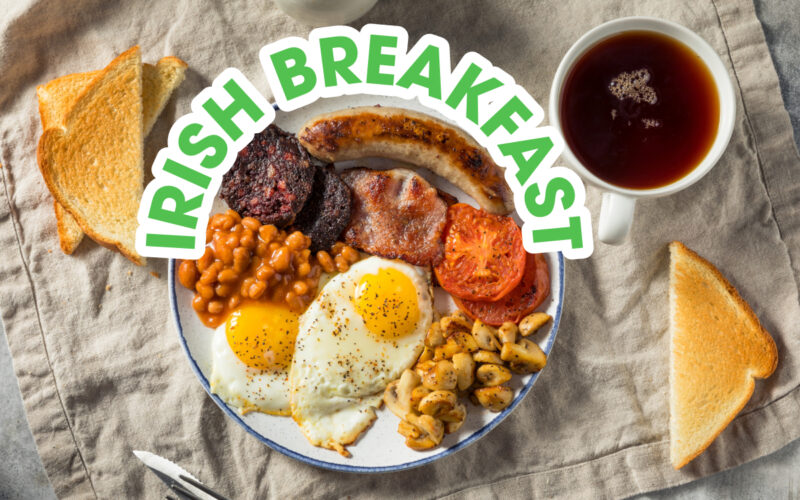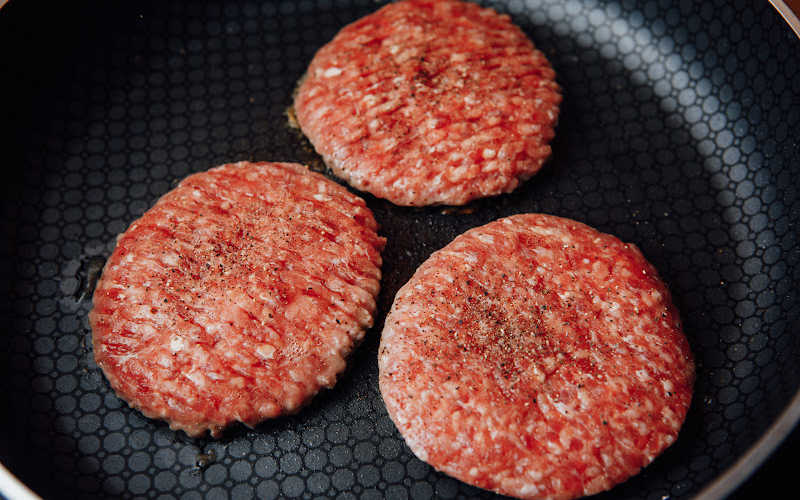Celebrate the flavors of a traditional full Irish breakfast

What is the traditional Irish breakfast?
A traditional full Irish breakfast is a hearty and substantial meal typically served in Ireland and parts of the United Kingdom. This breakfast is known for being filling and savory, providing a substantial start to the day. It’s often enjoyed on weekends or as a special treat on holidays. However, the exact components may vary slightly depending on personal preferences or regional variations.
It typically includes several components:

1. Irish bacon or rashers:
Irish bacon is typically cut from the back of the pig and is often thicker than the bacon commonly found in the United States. It may include both lean meat and streaks of fat, offering a balance of flavors and textures when cooked. It tends to be less salty and smoky, with a milder taste that allows the natural sweetness of the pork to shine through. The texture is also slightly meatier due to the thicker cut.
Traditional Irish bacon is cured rather than smoked. It undergoes a curing process where it’s rubbed with a mixture of salt and spices, such as black pepper and sometimes brown sugar or molasses, to enhance its flavor. This curing process helps preserve the meat and adds depth to its taste.
Irish bacon can be prepared in various ways, including frying, grilling, or baking. It’s commonly pan-fried until golden brown and crispy on the edges, but it can also be cooked to different levels of doneness based on personal preference.
Irish bacon has a rich cultural significance in Ireland, where it has been a staple of the diet for generations. It’s often associated with home-cooked meals, family gatherings, and traditional Irish celebrations.
While Irish bacon may be readily available in Ireland and some parts of the United Kingdom, it might be labeled differently or less commonly found in other regions. However, variations of Irish bacon can be found in specialty stores or through online retailers catering to international foods.
2. Pork sausages:
Often referred to as “Irish sausages” or “bangers,” these are pork sausages seasoned with herbs and spices.
Pork sausages are typically made from ground pork mixed with various seasonings and spices. Traditional Irish pork sausages often contain a blend of herbs such as sage, thyme, and parsley, along with spices like black pepper and nutmeg. The exact ingredients can vary based on regional preferences and family recipes.
Pork sausages are usually encased in natural casings or synthetic casings and formed into links or patties. They can be cooked in a variety of ways, including frying, grilling, or baking. Frying is a common method for preparing sausages for a full Irish breakfast, as it helps develop a crispy exterior while keeping the inside juicy and flavorful.
Irish pork sausages have a rich and savory flavor profile, with the pork being the predominant taste complemented by the herbs and spices used in the seasoning blend. The texture is typically moist and tender, providing a satisfying bite with each mouthful.
While pork sausages are the most common type used in a traditional full Irish breakfast, there are variations available, including beef sausages, chicken sausages, or even vegetarian alternatives made with plant-based ingredients. However, pork sausages remain the classic choice for an authentic Irish breakfast experience.
Pork sausages hold cultural significance in Irish cuisine and are a beloved part of traditional Irish breakfasts. They symbolize hearty, home-cooked meals and are often enjoyed as a comforting and satisfying dish, particularly on special occasions or weekend mornings.
Pork sausages are widely available in grocery stores and butcher shops, both in Ireland and in many other parts of the world. They are a versatile ingredient that can be incorporated into a variety of dishes beyond breakfast, including casseroles, stews, and pasta dishes.
3. Black pudding:
Black pudding, also known as blood pudding or blood sausage, is made from a mixture of pork blood, pork fat, and a binding agent such as oatmeal, barley, or breadcrumbs. The blood gives it a dark color and distinct flavor, while the other ingredients add texture and help bind the sausage together.
To make black pudding, the ingredients are mixed together and seasoned with spices such as pepper, nutmeg, and herbs like thyme or sage. The mixture is then stuffed into a casing and typically boiled or steamed until cooked through. It can be served sliced and fried or grilled before serving, which crisps up the exterior while keeping the interior moist and flavorful.
Black pudding has a rich, earthy flavor with a slightly savory and mildly metallic undertone from the blood. The spices and herbs used in the seasoning blend add complexity to the taste, while the texture can range from smooth and creamy to slightly grainy, depending on the recipe and cooking method.
Black pudding has a long history in Irish cuisine and is a traditional component of a full Irish breakfast. It’s valued not only for its unique flavor but also for its hearty and nourishing qualities. While it may not be to everyone’s taste, it holds a special place in Irish culinary traditions and is enjoyed by many as a comforting and satisfying dish.
Black pudding is widely available in Ireland and the United Kingdom, where it can be found in grocery stores, butcher shops, and specialty food stores. It’s also gaining popularity in other parts of the world, where it may be sold in specialty shops catering to international foods or online retailers.
4. White pudding:
White pudding is similar to black pudding but does not contain blood. Instead, it is made from a mixture of pork meat, pork fat, and a binding agent such as oatmeal, barley, or breadcrumbs. Additional seasonings such as salt, pepper, and herbs like parsley or thyme are often added for flavor.
The ingredients for white pudding are mixed together and stuffed into a casing, similar to black pudding. It is then typically boiled or steamed until cooked through. Like black pudding, it can be sliced and fried or grilled before serving, which helps to develop a crispy exterior while keeping the interior moist and flavorful.
White pudding has a mild and slightly savory flavor, with a texture that is typically smooth and creamy. The absence of blood gives it a lighter color compared to black pudding, and the seasoning blend adds depth and complexity to the taste. It pairs well with other components of a full Irish breakfast, complementing the flavors of bacon, sausages, and eggs.
While the basic recipe for white pudding remains consistent, there may be variations in seasoning and texture depending on regional preferences or family recipes. Some recipes may incorporate additional ingredients such as onions, garlic, or spices for added flavor.
White pudding is a staple of Irish cuisine and is often enjoyed as part of a traditional breakfast or served alongside other meat dishes. It is valued for its comforting and satisfying qualities, providing a hearty and nourishing addition to the meal.
White pudding is widely available in Ireland and the United Kingdom, where it can be found in grocery stores, butcher shops, and specialty food stores. It may also be available in other parts of the world with a significant Irish or British population or sold through online retailers specializing in international foods.
5. Fried eggs:
Fried eggs are made simply from eggs, typically chicken eggs, although duck or quail eggs may also be used. The eggs are cracked into a hot pan with a small amount of cooking fat, such as butter or oil.
To fry eggs, a frying pan is heated over medium heat, and a small amount of cooking fat is added to prevent sticking. Once the fat is hot, eggs are cracked into the pan, taking care not to break the yolks. The eggs are then cooked until the whites are set and the yolks reach the desired level of doneness. They can be cooked sunny-side up, over easy (flipped once to cook the yolk slightly), or over hard (flipped and cooked until both the whites and yolks are fully set).
Fried eggs have a rich, creamy yolk and tender, slightly firm whites. The flavor is rich and savory, with the yolks adding a creamy richness to the dish. Depending on how they’re cooked, the yolks can range from runny and golden to fully cooked and slightly firmer.
While fried eggs are typically cooked in a frying pan, there are many variations on how they can be prepared. They can be seasoned with salt and pepper or topped with cheese, herbs, or other ingredients for added flavor. They can also be incorporated into other dishes, such as breakfast sandwiches, salads, or grain bowls.
Fried eggs are a versatile and widely enjoyed dish in many cultures around the world, including Ireland. In a full Irish breakfast, they provide a delicious contrast to the savory meats and puddings, adding a touch of richness and flavor to the meal.
Eggs are widely available in grocery stores and markets, making fried eggs an accessible and convenient option for breakfast or any meal of the day. They are a versatile ingredient that can be enjoyed in a variety of dishes, from simple breakfasts to more elaborate brunches and dinners.
6. Grilled tomatoes:
Grilled tomatoes are typically prepared by slicing fresh tomatoes in half horizontally and grilling them until they are softened and slightly charred. They can be seasoned with salt, pepper, and herbs such as thyme or rosemary to enhance their flavor. Grilling adds a smoky depth to the tomatoes and helps to concentrate their natural sweetness.
Grilled tomatoes have a rich and savory flavor with a hint of sweetness from caramelization. The grilling process enhances their natural juiciness and brings out their bold, earthy undertones. They provide a refreshing contrast to the richer, meatier components of a full Irish breakfast, balancing out the overall flavor profile of the meal.
Tomatoes are rich in essential nutrients such as vitamins C and K, potassium, and antioxidants like lycopene. Grilling them preserves their nutritional content while imparting a delicious smoky flavor. They contribute to the overall healthfulness of a full Irish breakfast, adding vitamins and minerals to the meal.
Grilled tomatoes can be customized to suit individual preferences by adjusting the grilling time and seasoning. They can be cooked until they are just softened for a firmer texture or grilled longer for a more tender consistency. Additionally, they can be seasoned with a variety of herbs and spices to complement different flavor profiles.
While not exclusive to Irish cuisine, grilled tomatoes are a common accompaniment to a traditional full Irish breakfast. They add color, flavor, and freshness to the meal, making it more visually appealing and satisfying. Their inclusion in the breakfast spread reflects the emphasis on incorporating fresh, seasonal ingredients into Irish cooking.
Tomatoes are widely available in grocery stores and farmers’ markets, making them easily accessible for home cooks looking to recreate a full Irish breakfast. They can be sourced year-round, although they are at their peak during the summer months when they are in season.
7. Baked beans:
Baked beans are typically made from navy beans (also known as haricot beans) that are cooked in a sweet and tangy tomato-based sauce. The sauce often includes ingredients such as tomato paste, brown sugar, molasses, vinegar, and spices like mustard powder, onion powder, and paprika. The beans are simmered in the sauce until they are tender and flavorful.
Baked beans have a rich, savory-sweet flavor with a slightly tangy and smoky undertone from the tomato sauce and spices. The combination of sweetness from the brown sugar and molasses, acidity from the vinegar, and umami richness from the tomatoes creates a well-balanced and satisfying taste. Baked beans add depth and complexity to a full Irish breakfast, complementing the savory components of the meal.
Beans are a nutritious source of plant-based protein, fiber, vitamins, and minerals. They provide sustained energy and help keep you feeling full and satisfied throughout the morning. Baked beans are also low in fat and cholesterol-free, making them a healthy addition to a balanced breakfast.
Baked beans can be enjoyed in various ways, including as a side dish for breakfast, lunch, or dinner. They can be served hot or cold, depending on personal preference, and are often paired with toast, grilled tomatoes, sausages, bacon, or eggs. Baked beans can also be used as a topping for baked potatoes or incorporated into casseroles, soups, and stews.
While baked beans originated in North America, they have become a popular staple in Irish cuisine and are commonly served as part of a full Irish breakfast. Their inclusion in the breakfast spread reflects the influence of British and American culinary traditions on Irish cooking. Baked beans add warmth, comfort, and familiarity to the meal, making it a comforting and satisfying start to the day.
Baked beans are widely available in cans or jars at grocery stores and supermarkets, making them convenient and accessible for home cooks. They are a pantry staple for many households and can be stored for extended periods, making them a convenient option for quick and easy meals.
8. Fried mushrooms:
Fried mushrooms are typically made by slicing fresh mushrooms (such as button mushrooms or portobello mushrooms) and cooking them in a skillet with butter or oil until they are tender and golden brown. They can be seasoned with salt, pepper, garlic, and herbs like thyme or parsley to enhance their flavor. The frying process caramelizes the natural sugars in the mushrooms, resulting in a rich and savory taste.
Fried mushrooms have a savory, earthy flavor with a meaty texture that adds depth and complexity to a full Irish breakfast. The caramelization from frying enhances their natural sweetness and imparts a deliciously rich and aromatic aroma. Fried mushrooms pair well with the other savory components of the breakfast, adding a burst of umami-rich flavor to the meal.
Mushrooms are a nutritious source of vitamins, minerals, and antioxidants. They are low in calories and fat, high in fiber, and contain essential nutrients such as vitamin D, potassium, and B vitamins. Fried mushrooms provide a satisfying and nourishing addition to a full Irish breakfast, contributing to its overall healthfulness and balance.
Fried mushrooms can be customized to suit individual preferences by adjusting the cooking time and seasoning. They can be cooked until they are just tender for a firmer texture or cooked longer for a softer consistency. Additionally, they can be seasoned with a variety of herbs, spices, and aromatics to complement different flavor profiles.
While not exclusive to Irish cuisine, fried mushrooms are a common accompaniment to a traditional full Irish breakfast. They add depth, flavor, and visual appeal to the meal, making it more satisfying and enjoyable. Their inclusion in the breakfast spread reflects the emphasis on incorporating fresh, seasonal ingredients into Irish cooking.
Mushrooms are widely available in grocery stores and farmers’ markets, making them easily accessible for home cooks looking to recreate a full Irish breakfast. They can be sourced year-round and come in a variety of types and sizes, allowing for endless culinary possibilities.
9. Toast or soda bread:
Soda bread is a type of quick bread made from basic ingredients such as flour, baking soda (or bread soda), salt, and buttermilk. Traditional soda bread recipes do not include yeast, which means there is no need for proofing or lengthy rising times. The buttermilk reacts with the baking soda to create carbon dioxide bubbles, resulting in a light and tender texture.
To make soda bread, the dry ingredients are combined in a bowl, and the buttermilk is gradually added until a dough forms. The dough is shaped into a round loaf and scored with a cross on top to help it rise evenly while baking. The bread is then baked in a hot oven until golden brown and cooked through. Once cooled, the loaf can be sliced and toasted before serving.
Toasted soda bread has a hearty and slightly tangy flavor with a dense yet crumbly texture. The toasting process enhances its nutty, toasty notes and adds a satisfying crunch to each bite. Soda bread pairs well with the savory components of a full Irish breakfast, providing a neutral base that balances out the richness of the other ingredients.
Soda bread is a relatively simple and wholesome bread that is low in fat and cholesterol-free. It provides carbohydrates for energy and dietary fiber for digestive health. While it may not be as nutrient-dense as whole grain bread, soda bread is a nutritious option that adds substance and flavor to a full Irish breakfast.
Soda bread has a long history in Irish cuisine and is a symbol of traditional Irish baking. It has been enjoyed for generations as a staple food, particularly in rural communities where access to ingredients may have been limited. Soda bread is often served alongside meals like soups, stews, and, of course, a full Irish breakfast, where it adds warmth and comfort to the meal.
Soda bread is widely available in Ireland and in many specialty food stores around the world. It can also be made at home using simple ingredients and basic baking techniques. While traditional soda bread is made with plain flour, variations with added ingredients such as whole wheat flour, oats, or seeds are also popular.
10. Potato farls:
Potato farls are typically made from cooked mashed potatoes that are mixed with flour, salt, and sometimes butter or margarine. The mixture is kneaded until it forms a dough, which is then rolled out into a flat circle and cut into quarters or triangles. The farls are cooked on a griddle or skillet until they are golden brown and cooked through.
To make potato farls, cooked potatoes are mashed until smooth and then mixed with flour and salt to form a dough. Some recipes may also include butter or margarine for added richness and flavor. The dough is divided into portions and shaped into flat rounds or triangles, which are then cooked on a hot griddle or skillet until they develop a golden crust on both sides.
Potato farls have a hearty and comforting flavor with a soft and slightly chewy texture. The mashed potatoes give them a rich and creamy taste, while the flour adds structure and helps bind the dough together. The farls may be seasoned with salt or additional herbs and spices for added flavor, depending on personal preference.
Potato farls are a source of carbohydrates, providing energy to fuel your day. They also contain some dietary fiber, vitamins, and minerals from the potatoes. While they are not particularly high in nutrients, they can be part of a balanced diet when enjoyed in moderation as part of a meal.
Potato farls are a traditional Irish dish that has been enjoyed for generations. They are often served as part of a full Irish breakfast, where they add substance and flavor to the meal. Potato farls are also commonly enjoyed with other Irish dishes such as stews, soups, and seafood dishes, where they serve as a versatile accompaniment.
Potato farls are widely available in Ireland and in some specialty food stores outside of Ireland. They can also be made at home using simple ingredients and basic cooking techniques. Homemade potato farls allow for customization, allowing you to adjust the seasonings and texture to suit your preferences.











